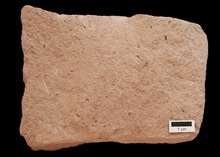Rhyolite
Rhyolite (/ˈraɪ.ə.laɪt, ˈraɪ.oʊ-/ RY-ə-lyte, RY-oh-) is an igneous, volcanic rock, of felsic (silica-rich) composition (typically > 69% SiO2 – see the TAS classification). It may have any texture from glassy to aphanitic to porphyritic. The mineral assemblage is usually quartz, sanidine and plagioclase (in a ratio > 2:1 – see the QAPF diagram). Biotite and hornblende are common accessory minerals. It is the extrusive equivalent to granite.
| Igneous rock | |
 | |
| Composition | |
|---|---|
| Felsic: igneous quartz and alkali feldspar (sanidine and sodic plagioclase), biotite and hornblende |
Geology
Rhyolite can be considered as the extrusive equivalent to the plutonic granite rock, and consequently, outcrops of rhyolite may bear a resemblance to granite. Due to their high content of silica and low iron and magnesium contents, rhyolitic magmas form highly viscous lavas. They also occur as breccias or in volcanic plugs and dikes. Rhyolites that cool too quickly to grow crystals form a natural glass or vitrophyre, also called obsidian. Slower cooling forms microscopic crystals in the lava and results in textures such as flow foliations, spherulitic, nodular, and lithophysal structures. Some rhyolite is highly vesicular pumice. Many eruptions of rhyolite are highly explosive and the deposits may consist of fallout tephra/tuff or of ignimbrites.
Eruptions of rhyolite are relatively rare compared to eruptions of less felsic lavas. Only three eruptions of rhyolite have been recorded since the start of the 20th century: at the St. Andrew Strait volcano in Papua New Guinea, Novarupta volcano in Alaska, and Chaiten in southern Chile.
Occurrence
Rhyolite has been found on islands far from land, but such oceanic occurrences are rare.[1]
.jpg)
Europe
- Copper Coast Geopark in southeast Ireland
- Etsch Valley Vulcanite Group near Bolzano and the surrounding area
- Gréixer rhyolitic complex at Moixeró range (Catalonia, Spain)[2]
- Iceland: all active and extinct central volcanoes, e.g. Torfajökull, Leirhnjúkur / Krafla, Breiddalur central volcano
- Massif de l'Esterel, France
- Papa Stour in Shetland
- Various locations around Snowdonia, Wales
- Vosges
Germany
- Black Forest e.g. on the Karlsruher Grat
- Odenwald
- Rotliegendes
- Saxony, especially the north west
- Saar-Nahe Basin e.g. the Königstuhl (Pfalz) on the Donnersberg mountain
- Saxony-Anhalt north of Halle
- The Thuringian Forest consists mainly of rhyolites, latites and pyroclastic rocks of the
The Americas
- Cascade Range[3]
- Castle Rock, Colorado
- Cobalt, Ontario[4]
- Crater Lake, Oregon[1]
- Jemez Mountains
- Mount Jasper, Berlin, New Hampshire
- Mount Kineo, a volcanic plug; an iconic mountain feature located in Moosehead Lake, Rockwood, Maine
- Palisade Head, a formation found at Tettegouche State Park, Minnesota
- Rhyolite, Nevada was named after a rhyolite deposit that characterises the area.[5]
- San Juan volcanic field[6]
- Sheep Creek, Idaho
- St. Francois Mountains
- Wichita Mountains within the Southern Oklahoma Aulacogen
- Yellowstone
Oceania

- The Flinders Peak Group and the Teviot Range in the Fassifern Valley of Queensland, Australia is a rhyolite
- Glass House Mountains National Park, Queensland, Australia
- The Gondwana Rainforests of Australia World Heritage Area contains rhyolite-restricted flora along the Great Dividing Range.
- The Taupo Volcanic Zone in New Zealand has a large concentration of rhyolite volcanoes.
Asia
Africa
Name
The name rhyolite was introduced into geology in 1860 by the German traveler and geologist Ferdinand von Richthofen[9][10][11] from the Greek word rhýax ("a stream of lava")[12] and the rock name suffix "-lite".[13]
Quarrying by Native Americans
In North American pre-historic times, rhyolite was quarried extensively in eastern Pennsylvania in the United States. Among the leading quarries was the Carbaugh Run Rhyolite Quarry Site in Adams County. Rhyolite was mined there starting 11,500 years ago.[14] Tons of rhyolite were traded across the Delmarva Peninsula,[14] because the rhyolite kept a sharp point when knapped and was used to make spear points and arrowheads.[15]
Characteristics
See also
- Comendite – A hard, peralkaline igneous rock, a type of light blue grey rhyolite
- List of rock types – A list of rock types recognized by geologists
- Pantellerite – A peralkaline rhyolite type of volcanic rock
- Thunderegg – A nodule-like rock, that is formed within rhyolitic volcanic ash layers
References
- The Illustrated Encyclopedia of Rocks of the World by John Farndon, page 54.
- J. Martí, G.J. Aguirre-Díaz, A. Geyer. "The Gréixer rhyolitic complex (Catalan Pyrenees): an example of Permian caldera". Workshop on Collapse Calderas – La Réunion 2010. IAVCEI – Commission on Collapse Calderas.
- Cascades Volcano Observatory. "Cascades Volcano Observatory". usgs.gov. Retrieved 19 January 2015.
- ROBERT CINITS. "The Proteus Property" (PDF).
- "Rhyolite Ghost Town". Retrieved 2009-12-22.
- Lipman, P.W. (1987). Rare-Earth-Element Compositions of Cenozoic Volcanic Rocks in the Southern Rocky Mountains and Adjacent Areas (USGS Bulletin 1668) (PDF). Washington D.C.: USGS. p. 4.
- http://www.volcanodiscovery.com/changbaishan.html. Missing or empty
|title=(help) - "Yandang Shan". Archived from the original on 2016-02-17. Retrieved 2011-12-22.
- Richthofen, Ferdinand Freiherrn von (1860). "Studien aus den ungarisch-siebenbürgischen Trachytgebirgen" [Studies of the trachyte mountains of Hungarian Transylvania]. Jahrbuch der Kaiserlich-Königlichen Geologischen Reichsanstalt (Wein) [Annals of the Imperial-Royal Geological Institute of Vienna] (in German). 11: 153–273.
- Simpson, John A.; Weiner, Edmund S. C., eds. (1989). Oxford English Dictionary. 13 (2nd ed.). Oxford: Oxford University Press. p. 873.
- Young, Davis A. (2003). Mind Over Magma: The Story of Igneous Petrology. Princeton University Press. p. 117. ISBN 0-691-10279-1.
- "Definition of RHYOLITE". www.merriam-webster.com.
- "Definition of LITE". www.merriam-webster.com.
- Fergus, Charles (2001). Natural Pennsylvania: Exploring the State Forest Natural Areas. Stackpole Books. p. 30. OCLC 47018498.
- Bricker, Dakota. "Snaggy Ridge Indian Rhyolite Quarries". Mercersburg Historical Society. Retrieved 2019-01-20.
External links
| Wikimedia Commons has media related to: |
